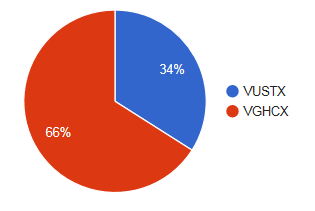|
Mutual Funds
As in the graphic, a nearly two-thirds investment in Vanguard's original health care fund, VGHCX, plus about one-third in Vanguard's long-term treasury bond fund, VUSTX, if rebalanced annually, with all distributions reinvested and no redemptions, would, per Portfolio Visualizer, have taken a $10,000 investment at the beginning of January, 1995, to almost $165,000 today and with a worst year performance of just negative 5.53%. For the same period, an equal investment in the S&P 500 Index, as represented by Vanguard's original S&P 500 fund, VFINX, would also have gone up nicely, but today would be worth less than $91,000 and would have had a worst year performance of negative 37.02%.

A 34% allocation in Vanguard Long-Term Treasury, Investor Shares, plus a 66% allocation in Vanguard Health Care, Investor Shares.
I am not necessarily recommending this combination for the future. A health care fund is rather specialized and might or might not continue to perform as well long-term as this one did over the past couple decades or so. The point, though, is that winning sets of mutual funds can be found that can in fact do better in absolute and risk-adjusted terms than the major market indexes.
| |